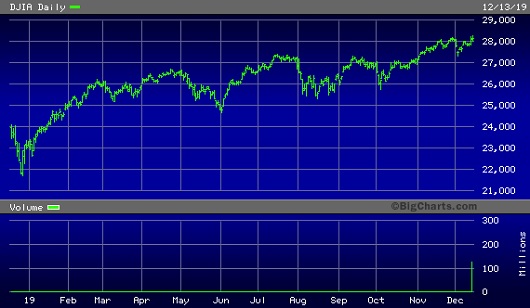By Pam Martens and Russ Martens: December 16, 2019 ~
One has to wonder how much money it would take for the New York Fed to throw at Wall Street before the New York Times reports to its readers on the biggest Wall Street bailout by the Fed since the financial crisis.
Last Thursday, December 12, the New York Fed announced that over the next month it would shower the trading houses (primary dealers) on Wall Street with a total of $2.93 trillion in short-term loans. The money is for a Wall Street liquidity crisis that has yet to be explained in credible terms to the American people and yet the New York Times does not appear to have an investigative reporter assigned to investigate what’s really going on just 11 years after those same trading houses blew themselves up in the biggest financial crash since the Great Depression and took the U.S. economy along for the ride.
The New York Fed’s repo (repurchase agreement) loan program began on September 17 when repo loan rates spiked from approximately 2 percent to 10 percent – meaning either liquid funds were not available to loan or the mega banks on Wall Street were backing away from lending to certain counterparties. Repo loans are typically between banks, hedge funds and money market funds on an overnight basis and are made against good-quality collateral. Since that time, the New York Fed has been making these loans to the tune of hundreds of billions of dollars weekly.
The New York Times covered the subject in September. Then an eerie silence took hold in October and November as the Fed continued to pump out over $3 trillion in cumulative loans to Wall Street’s trading houses. On December 8 and December 12, the New York Times simply ran articles by Reuters on the Fed’s loans, which are the first of their kind since the financial crisis.
The $2.93 trillion that the New York Fed will funnel to Wall Street over the next month consists of up to $120 billion each weekday in overnight loans through January 14 and $440 billion in term loans ranging from 3-days to 32 days. In addition, during the last week of the year (on Tuesday, Wednesday and Thursday) the Fed will bump up its overnight loan offerings to $150 billion from $120 billion, thus providing an additional $90 billion that week.
Adding to the suggestion that liquidity remains tight on Wall Street despite the Fed’s loans, the New York Fed offered a $50 billion 32-day term loan this morning and it was oversubscribed by $4.25 billion.
The Wall Street Journal’s Michael Derby reported this massive new money spigot from the Fed after it was announced last Thursday but he wrote this regarding the source of the problem:
“The apparent cause of that spike was a large tax payment date and settlements for Treasury debt auctions that affect how much money was available in the banking system.”
That was the official-speak from the Federal Reserve and relates to what happened on September 17. It does not explain why the Fed has had to continue throwing hundreds of billions of dollars each week at Wall Street’s trading houses after those corporate tax payments and Treasury auctions were long out of the picture.
Would the Federal Reserve, the central bank of the United States, actually lie to the American people? If withholding material facts from the American people constitutes a lie, then yes, the Federal Reserve has a troubled history.
In the leadup to the financial collapse on Wall Street in September 2008, the Fed created in March of that year a lending program very similar to what it is doing today. It called it the Single Tranche Open Market Operation (ST OMO) and attempted to pass it off as part of its routine open market operations. But when the Levy Economics Institute took a hard look at where the ST OMO money went, it found that “77 percent ($657.91 billion) of all transactions were conducted with foreign-based institutions.” The largest of those were Credit Suisse of Switzerland which received 30.3 percent of the funds; Germany’s Deutsche Bank, which borrowed 11.8 percent of the money; and France’s BNP Paribas, which took down 11.3 percent of the funds borrowed.
According to data compiled by the Levy Economics Institute, the Fed’s bailout of Wall Street during the financial crisis amounted to a staggering $29 trillion (including the central bank liquidity swap lines, CBLS) – a sum that neither the American people nor Congress would learn about until years after the loans had been made and a multi-year court battle by the Fed to suppress the information had been won by media outlets.
The largest amounts of the $29 trillion did not go to commercial banks to shore up the U.S. economy through consumer loan relief or business loans. It went to three of the largest trading houses on Wall Street. Citigroup received $2.65 trillion; Merrill Lynch received $2.43 trillion; and Morgan Stanley received $2.27 trillion. (See page 33 at this link.) The fourth largest was not even a bank or Wall Street firm. It was AIG, a large insurance company that Wall Street’s trading houses had buried as the counterparty to their derivative bets. AIG got a cool $1 trillion in loans from the Fed.
The chart below suggests that today’s Fed loans, which are not going to commercial banks but to the trading units of those banks, are being used to artificially prop up the stock market. The Dow Jones Industrial Average has mounted a rally since the Fed turned on its money spigot on September 17. (How else can you have a stock rally in the midst of a liquidity crisis on Wall Street?) Instead of performing its mandate as a lender of last resort to the commercial banks of the U.S., the New York Fed seems to be settling into its assumed role as the stock market’s lender of last resort to facilitate a liquidity exit ramp for the one percent who own the bulk of the stock market.



